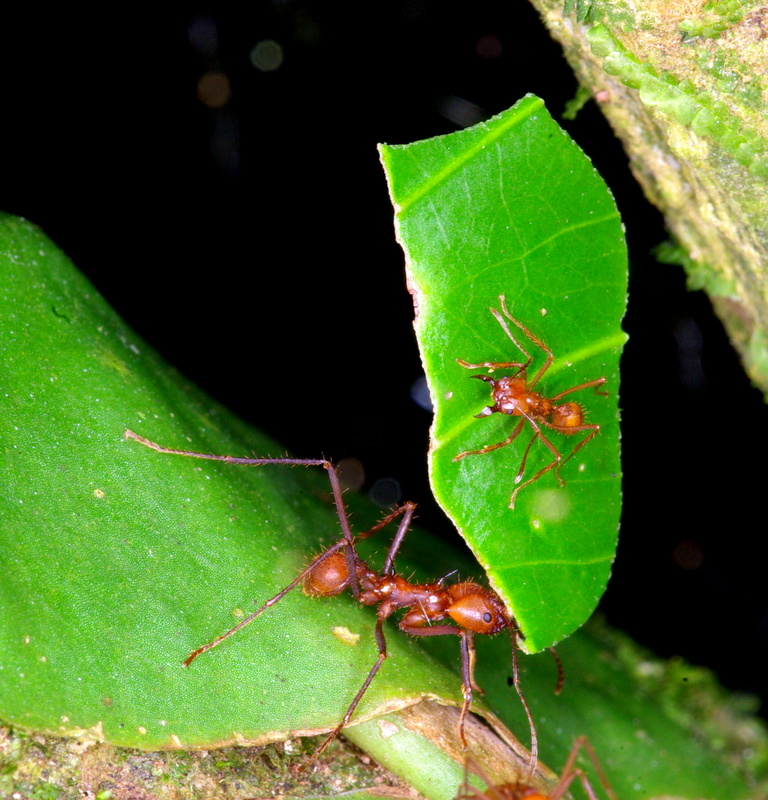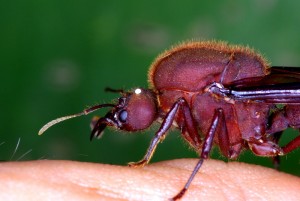 Several times I’ve started these little essays with “I was walking from the house to the Dining Hall to have breakfast when…” And it is true, these short walks, including from the house to the office or lab, or a short hike down a trail usually brings me into contact with something unique, unusual, perhaps even common in the big scale of things, but extraordinary nonetheless. So you can only imagine having a couple of hundred people “walking from here to there” every day encountering the extraordinary and you will understand why this is such a remarkable place to live and work. Consistently, conversations at breakfast revolve around someone showing off a picture of a tamandua (a tropical anteater) carrying a baby on its back, its orange/cream-colored fur broken by a “vest” of darker pelage; or the image of a blue-glowing scorpion under a UV light, eerie and ghostly, encountered during a night hike to a high spot next to a wetland; or the tale of rare birds walking in front of someone on a trial or near a stream, or the amazing viper resting by the side of a trail, or the ocelot hunting frogs in the swamp and on and on.
Several times I’ve started these little essays with “I was walking from the house to the Dining Hall to have breakfast when…” And it is true, these short walks, including from the house to the office or lab, or a short hike down a trail usually brings me into contact with something unique, unusual, perhaps even common in the big scale of things, but extraordinary nonetheless. So you can only imagine having a couple of hundred people “walking from here to there” every day encountering the extraordinary and you will understand why this is such a remarkable place to live and work. Consistently, conversations at breakfast revolve around someone showing off a picture of a tamandua (a tropical anteater) carrying a baby on its back, its orange/cream-colored fur broken by a “vest” of darker pelage; or the image of a blue-glowing scorpion under a UV light, eerie and ghostly, encountered during a night hike to a high spot next to a wetland; or the tale of rare birds walking in front of someone on a trial or near a stream, or the amazing viper resting by the side of a trail, or the ocelot hunting frogs in the swamp and on and on.
This morning, as I reached the base of the Stone Bridge on my way to breakfast, Meylin, one of the station maintenance staff, looked at me form the small Visitor Center with a large question painted on her face. She pointed at the wood floor of the building’s porch. It was covered with large insects. That’s usually my cue. Bugs are “Carlosmagnetic”. I can’t resist checking them out. Whipping out my little pocket camera as I walked, I approached the porch. There, scattered on the hardwood planks, on the shelves where students sign their registration, and on every other surface was a collection of sleepy-looking leaf, winged leaf-cutter ants. At first, I thought it was a swarm of queens, gravid females that emerge in synchrony during the night for their nuptial flights, followed by thousands of males in pursuit of a mate. These ended up being all males.
We collected them into a plastic container and saved them for further photos and positive identification. However, I was in for much more than that later in the day.
Dr. Jacobus Boomsma is an entomologist working at the Institute of Biology, University of Copenhagen, in Denmark, and is a world renowned expert on ants. His topics of interest in ant biology read like science-fiction stories, involving conflict and cooperation among ant societies, parasites, mutualistic species, ants that grow fungus gardens and butterflies that live inside the nest of ants. He has done extensive work in Panama, at the Smithsonian Tropical Research Institute in Barro Colorado Island. He happened to be visiting La Selva for a couple of days. Ronald Vargas, our Research Coordinator, brought him to my office and, of course, I offered them “a snack” consisting of a plastic tray filled with squirming large winged ants.
“Oh, Atta cephalotes,” he said with interest. “You know these are all males, of course.” Of course, I knew that…sort of. Actually, they looked to me like large females at first, but then I had found a larger even, darker specimen and have added to the group, thinking “THIS is the queen.” And I was right.
“The males have these little heads. They don’t have to think much,” Dr. Boomsma said. “They only have to mate.”
The female, on the other hand, has a full complement of mandibles, a stout body filled with fat and perhaps eggs, a secret storage chamber where a precious sample of the fungus these ants grow is stored, and a life expectancy of somewhere around 20 years! Now, that last bit I didn’t know.
But the story gets more interesting. The whole nuptial flight, mating and subsequent activities are highly structured and sequential. Some things will not happen unless the previous scene plays out. For example, when I got to the Visitor Center in the morning, pretty much everything that was supposed to happen, had already happened the night before. The lights left on all night on the porch of the building short-circuited the sequence of behaviors for the few hundred males and a couple of females we found. These, attracted to the lights, failed to mate and thus got trapped by the light on the porch, for me to find and collect in the morning.
For the others, the story went somewhat like this. Males and females emerged in mass from their underground nest. Winged and mobile, they flew into the darkness guided to each other proably by smell. Each female mated with several males, collecting sperm for storage. This is the only time in her life she will mate and, amazingly, the sperm collected will have to last her a life time, all 20-odd years of it! Dr. Boomsma said, “Think that for us to store sperm for any length of time, we have to freeze it in liquid Nitrogen and store it at great cost. These females can store viable sperm at room temperature, in their bodies (without rejecting this foreign matter) for many years!”
Not only that, but the sperm is miserlily doled up during the fertilization of the eggs. Somehow the female is able to provide only three or four single sperm cells to fertilize each egg, from the roughly 30 or 40 million it collected from her mates. Over the life time of a colony, this single female can produce 5 million or more workers, males and future queens, all from that single night’s events.
Once fertilized, a new series of behaviors begin, starting with the loss of her wings and the location of a suitable spot to begin her new colony. Alone with its precious cargos (the valuable sperm and the spores of the fungus that will become the sole food source for the entire colony) she digs a hole on the ground and entombs herself in a small chamber. Here, she begins to metabolize her now-useless flight muscles. She will never have to fly again, so this protein will be used to make the first few eggs of her nascent colony. Also, she will begin to metabolize the accumulated fat that she stored while in the mother colony. The new queen will continue to produce eggs, fertilize them with the stored perm, and raise the first generation of workers for the next two months, without food, without water (perhaps the moisture on the soil around her), without light. By the time the first few workers venture outside in search of leaves to cut and bring to the nest to start the incredible fungus gardens, the queen is near starvation, depending now on the labor of her daughters to survive and for the colony to thrive.
There’s much  more to this story and researchers continuously discover new nuances, uncovering details, and mysteries that only new technologies allow us to get glimpses now. Leaf-cutter ants form one of the most complex, extraordinary and productive societies in the insect world, comparable only to certain bees in their intricate behaviors, and of course, to our own human societies. Every time I see a leaf-cutter ant’s trail, the workers laden with bits and pieces of vegetation, and think of the tons of organic matter thus processed, and the humble and against-all-odds beginning of that colony, I can’t help feeling excited and marveled at the amazing world we live in and have the privilege to study and write about.
more to this story and researchers continuously discover new nuances, uncovering details, and mysteries that only new technologies allow us to get glimpses now. Leaf-cutter ants form one of the most complex, extraordinary and productive societies in the insect world, comparable only to certain bees in their intricate behaviors, and of course, to our own human societies. Every time I see a leaf-cutter ant’s trail, the workers laden with bits and pieces of vegetation, and think of the tons of organic matter thus processed, and the humble and against-all-odds beginning of that colony, I can’t help feeling excited and marveled at the amazing world we live in and have the privilege to study and write about.
Carlos de la Rosa

Recent Comments